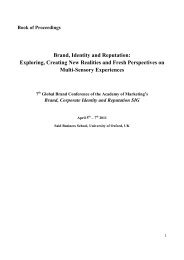Development of Subsea Altimeter Sensor System (SASS) Using ...
Development of Subsea Altimeter Sensor System (SASS) Using ...
Development of Subsea Altimeter Sensor System (SASS) Using ...
Create successful ePaper yourself
Turn your PDF publications into a flip-book with our unique Google optimized e-Paper software.
Full Paper<br />
Int. J. on Recent Trends in Engineering and Technology, Vol. 8, No. 2, Jan 2013<br />
3) Round transducer sensor with 7.5m cable, 45 o beam angle<br />
4) With fish depth scale and audible fish alarm<br />
5) User selectable meter or feet readings<br />
6) Range <strong>of</strong> depth readout from 0.3m up to 100 meters<br />
7) Display bottom rock or grass<br />
TABLE I: SPECIFICATIONS OF PORTABLE FISH FINDER<br />
(b)<br />
Figure 4: (a) At 50 cm level <strong>of</strong> <strong>Sensor</strong><br />
<strong>Sensor</strong><br />
(b) At 30 cm level <strong>of</strong><br />
The propagation characteristic <strong>of</strong> acoustics underwater<br />
highly depends on local environmental factors such as<br />
distance from the ocean surface and depth to the sea-bed as<br />
well as salinity and temperature in the water [1]. As a result,<br />
an error control code system that is designed for one<br />
particular depth may not work well for a different depth. For<br />
example a coding system with high redundancies is required<br />
for shallow water transmission since the acoustic signal could<br />
be reflected by the ocean surface randomly. In fact in a series<br />
<strong>of</strong> experiments [2] showed that up to 20% <strong>of</strong> the signal could<br />
be lost due to the reflection from the ocean surface for the<br />
particular set <strong>of</strong> equipment they used.<br />
II. THEORY<br />
Sonar sensor contains two main parts which are<br />
transmitter and receiver as shown in Figure 5. These two<br />
parts have their own function. The transmitter will emit the<br />
pulse meanwhile the receiver will receive the pulse that<br />
bounce back when hit an object under the water. The reflected<br />
<strong>of</strong> the pulse is known as echo [8][14].<br />
Figure 3:Portable Fish Finder attached to ROV and tested on lab<br />
pool<br />
Figure 5: How sonar sensor works<br />
The sensor has limitation <strong>of</strong> the coverage area. Since it<br />
works at 200 kHz, the capable coverage is only 60p . That<br />
means the object outside the area will not be detected by the<br />
sensor. In the process <strong>of</strong> transmitting the pulse, there should<br />
be no interruption until the pulses reach the seabed [9]. Any<br />
kind <strong>of</strong> interruption will cause a defect in process <strong>of</strong> data<br />
taken. In the other words, the efficiency <strong>of</strong> sensor will be<br />
affected because <strong>of</strong> interruption [10-12] .Figure 6 shows the<br />
transducer works to measure depth <strong>of</strong> water. The frequency<br />
used for the <strong>SASS</strong> is 200k Hz. Wavelength <strong>of</strong> <strong>SASS</strong> is about<br />
1.5km length.<br />
(a)<br />
Figure 4 shows the <strong>SASS</strong> are tested with different depth<br />
to identify the tolerance <strong>of</strong> error as discussed in next section.<br />
© 2013 ACEEE<br />
DOI: 01.IJRTET.8.2.39<br />
111<br />
(a)
















